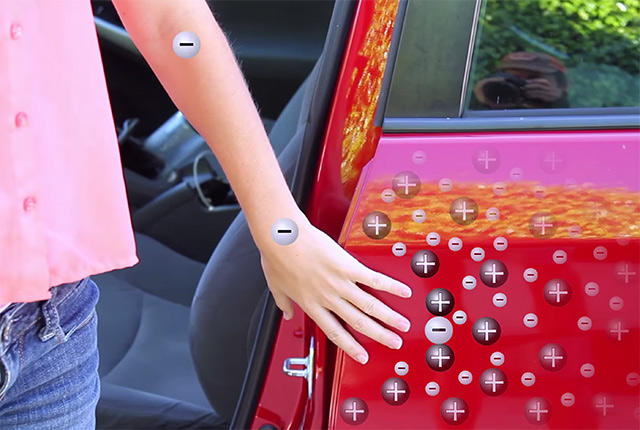How To Of The Day: Avoid Static Shock When Exiting Your Car
As the weather gets colder and dryer, you are more likely to get shocked when getting out of a car, touching a door knob, or doing laundry. Is there a way to prevent getting shocked on the car door? You bet there is!
Enjoy!
If you’ve ever wondered why your car will sometimes give you a painful shock when you climb out, this video explains the science behind it, and how to prevent it.
In this video from the Physics Girl YouTube channel, host Dianna Cowern explains exactly why exiting your car can cause a nasty static shock when you touch the outside of it. When you get out of the car, you slide your body across the seat, and that can leave both the seat and your body statically charged. If the air is cold and dry enough, the charge will quickly and violently transfer from your body into the car’s metal and shock you. Cowern suggests the easiest way to avoid this is by touching the metalwhile you exit the vehicle. Even if charge builds up, it will slowly flow from your body to the metal without creating the violent “shocking” event.
A Physics Exam
The story of a Physics student who got the following question in an exam:
“You are given an accurate barometer, how would you use it to determine the height of a skyscraper? ”
He answered: “Go to the top floor, tie a long piece of string to the barometer, let it down until it touches the ground and measure the length of the string”.
The examiner wasn’t satisfied, so they decided to interview the guy:
“Can you give us another method, one which demonstrates your knowledge of Physics? ”
“Sure, go to the top floor, drop the barometer off, and measure how long before it hits the ground…”
“Not, quite what we wanted, care to try again? ”
“Make a pendulum of the barometer, measure its period at the bottom, then measure its period at the top…”
“.another try? ….”
“Measure the length of the barometer, then mount it vertically on the ground on a sunny day and measure its shadow, measure the shadow of the skyscraper….”
“….and again? ….”
“Walk up the stairs and use the barometer as a ruler to measure the height of the walls in the stairwells.”
“…One more try? ”
“Find where the janitor lives, knock on his door and say, Please, Mr. Janitor, if I give you this nice Barometer, will you tell me the height of this building? ”
Slapshots In Slow Motion
Slapshots In Slow Motion
The physics behind a successful slapshot and why hockey sticks snap.
The slapshot is the fastest shot in hockey. One satisfying thwack and the puck goes flying at incredible speeds. Except it’s not really one thwack, it’s two, and our buddy Destin at Smarter Every Day has both the science know-how and the super high-speed slow-motion cameras to show you exactly how it works.
Turns out that as the stick hits the ice first it bends back a little, storing potential energy. Then, as it is lifted, it springs forward off the ice, giving the puck a powerful flick that’s actually faster than the hockey player’s follow-through would otherwise be. The wide-angle lens and 3200 frames per second frame rate do a perfect job of illustrating it.
Also, covered in this video: How the flex on hockey sticks is rated, and what happens when you crush a hockey puck with 80,000 pounds worth of force (spoiler: awesomeness). The whole video is a must watch for any hockey fan. It’s one thing to know the rules of the sport you love; it’s another to know the rules of physics it follows.



